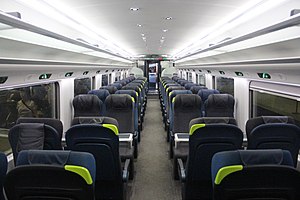
Back بريتش ريل كلاس 373 Arabic TGV-TMST Catalan TGV Eurostar Czech TGV TMST German British Rail Class 373 English TGV TMST EO Serie 373 de British Rail Spanish بریتیش ریل کلاس ۳۷۳ FA Eurostar (juna) Finnish TGV TMST French
| |
|---|---|
 A refurbished Class 373 at Gare d'Albertville in 2018 | |
 The standard-class interior of a refurbished Class 373 | |
| In service | 14 November 1994 – present |
| Manufacturer | |
| Built at |
|
| Family name | TGV |
| Constructed | 1992–1996 |
| Number built |
|
| Number in service | 11 |
| Number scrapped | 16 |
| Successor | |
| Formation |
|
| Capacity |
|
| Operators | Eurostar |
| Depots | Current:
|
| Specifications | |
| Car body construction | Steel |
| Train length | 387 m (1,269 ft 8 in) |
| Car length |
|
| Width | 2.81 m (9 ft 3 in) |
| Maximum speed | 300 km/h (186 mph) |
| Weight |
|
| Traction system | GEC Alsthom GTO-VVVF |
| Traction motors |
|
| Power output | |
| Tractive effort | |
| Electric system(s) | |
| Current collector(s) |
|
| UIC classification | (See § Set formation) |
| Safety system(s) | |
| Coupling system | Scharfenberg |
| Track gauge | 1,435 mm (4 ft 8 1⁄2 in) standard gauge |
The British Rail Class 373 or TGV-TMST train is an electric multiple unit that operates Eurostar's high-speed rail service between Britain, France and Belgium via the Channel Tunnel. Part of the TGV family, it has a smaller cross-section to fit within the constrictive British loading gauge, was originally able to operate on the UK third rail network, and has a lot of fireproofing in case of fire in the tunnel. This is both the second-longest—394 metres (1,293 ft)—and second-fastest train in regular UK passenger service. In 2015, the new Eurostar class 374 (e320’s) started being rolled out making the class 373’s going for scrap. As of 2017, 11 sets remain in service. In 1997, Great North Eastern Railway (GNER) ordered a few trains for use on the ECML and were retired in 2005. TGV hired these trains on their lines. As of 2016, all units remain in storage with no plans to return to service. These trains also ran on third rail towards London Waterloo. As of 2017, all but a few TGV TMST’s are in new Eurostar Blue livery.
- ↑ Milner, Chris (October 2008). "Eurostar's new home". The Railway Magazine. Vol. 154, no. 1290. pp. 23–26. ISSN 0033-8923.
- ↑ 2.0 2.1 2.2 Kaller, Roger; Allenbach, Jean-Marc (1995). Traction électrique (PDF) (in French). Lausanne: Presses polytechniques et universitaires romandes. p. 8.5.12. Archived (PDF) from the original on 27 February 2014. Retrieved 23 February 2014.
<ref group=ex> tags on this page, but the references will not show without a {{reflist|group=ex}} template (see the help page).